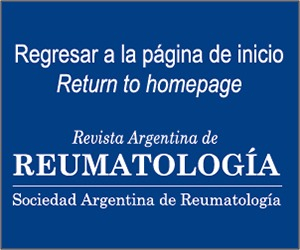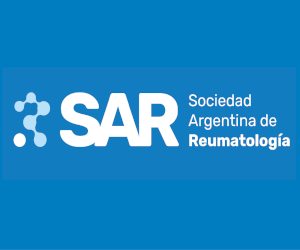Reference values for the 1-minute sit-to-stand test in pediatric patients with juvenile idiopathic arthritis
Abstract
Introduction: children with juvenile idiopathic arthritis (JIA) experience periods of pain and immobility that affect their physical capacities. Objectives: to describe reference values for the 1-minute sit to stand test (1-STS) in children with JIA as an assessment of aerobic-functional capacity and lower limb muscle strength. Materials and methods: an observational study was conducted, including 15 children with JIA aged between 5 and 16 years. Their performance in the 1-STS was assessed. Results: a significant positive correlation was found between the 1-STS and the 6-Minute Walk Test (r=0,56; p=0,03), as well as with the Functional Capacity Index (CAPFUN) (r=0,54; p=0,03). No significant correlations were observed between the Childhood Health Assessment Questionnaire (CHAQ) and the 1-STS (r=-0,21; p=0,44), nor with the Juvenile Arthritis Disease Activity Score (JADAS-10) (p=0,83). Conclusions: the 1-STS appears promising for assessing aerobic-functional capacity and lower limb muscle strength in children with oligoarticular JIA.References
II. De Inocencio Arocena J, Gascón CU. Artritis idiopática juvenil. Criterios de clasificación. Índices de actividad. Protoc Diagn Ter Pediatr 2020;2:27-36.
III. Rochette E, Duché P, Merlin E. Juvenile idiopathic arthritis and physical activity: possible inflammatory and immune modulation and tracks for interventions in young populations. Autoimmun Rev. 2015;14(8):726-34. doi: 10.1016/j.autrev.2015.04.007.
IV. Nigrovic PA, Colbert RA, Holers VM, Ozen S, Ruperto N, Thompson SD, et al. Biological classification of childhood arthritis: roadmap to a molecular nomenclature. Nat Rev Rheumatol 2021 May;17(5):257-269. doi: 10.1038/s41584-021-00610-5.
V. Mannion ML, Cron RQ. Therapeutic strategies for treating juvenile idiopathic arthritis. Curr Opin Pharmacol 2022 Dec;64:102226. doi: 10.1016/j.coph.2022.102226.
VI. Stevanovic D, Susic G. Health-related quality of life and emotional problems in juvenile idiopathic arthritis. Qual Life Res 2013 Mar;22(3):607-12. doi: 10.1007/s11136-012-0172-0.
VII. García-Galicia A, Hernández-Sánchez V, Santaella-Avalos A, Martínez-Hernández AJ, Montiel-Jarquín ÁJ, Barranco-Cuevas IA, et al. Evaluación de la calidad de vida y la actividad de la enfermedad en artritis idiopática juvenil. Rev Med Inst Mex Seguro Soc 2021;59(2):133-40.
VIII. Rebane K, Ristolainen L, Relas H, Orenius T, Kautiainen H, Luosujärvi R, et al. Disability and health-related quality of life are associated with restricted social participation in young adults with juvenile idiopathic arthritis. Scand J Rheumatol 2019;48(2):105–13. doi: 10.1080/03009742.2018.1493140.
IX. Hyrich KL, Lal SD, Foster HE, Thornton J, Adib N, Baildam E, et al. Disease activity and disability in children with juvenile idiopathic arthritis one year following presentation to pediatric rheumatology. Results from the Childhood Arthritis Prospective Study. Rheumatology (Oxford) 2010;49(1):116-22. doi: 10.1093/rheumatology/kep352.
X. Klepper SE. Measures of pediatric function: The child health assessment questionnaire (CHAQ), juvenile arthritis functional assessment report (JAFAR), juvenile arthritis functional assessment scale (JAFAS), juvenile arthritis functional status index (JASI), and pediatric orthopedic surgeons of north America (POSNA) pediatric musculoskeletal functional health questionnaire. Arthritis Rheum 2003;49(S5):S5-14. doi: 10.1002/art.11398.
XI. Iglesias MJ, Cuttica RJ, Herrera Calvo M, Micelotta M, Pringe A, Brusco MI. Design and validation of a new scale to assess the functional ability in children with juvenile idiopathic arthritis (JIA). Clin Exp Rheumatol 2006;24(6):713-8.
XII. Mian Q, Rumsey DG, Verschuren O, Moez EK, Roy M, Kaup C, et al. Reference values for the six-minute walk test in children with Juvenile Idiopathic Arthritis. Phys Occup Ther Pediatr. 2022;42(2):187-97. doi: 10.1080/01942638.2021.1934239.
XIII. Woolnough L, Pomputius A, Vincent HK. Juvenile idiopathic arthritis, gait characteristics and relation to function. Gait Posture 2021;85:38-54. doi: 10.1016/j.gaitpost.2020.12.010.
XIV. Rider LG, Werth VP, Huber AM, Alexanderson H, Rao AP, Ruperto N, et al. Measures of adult and juvenile dermatomyositis, polymyositis, and inclusion body myositis: Physician and Patient/Parent Global Activity, Manual Muscle Testing (MMT), Health Assessment Questionnaire (HAQ)/Childhood Health Assessment Questionnaire (C-HAQ). Arthritis Care Res (Hoboken) 2011;63(S11):S118-57. doi: 10.1002/acr.2053.
XV. Haile SR, Fühner T, Granacher U, Stocker J, Radtke T, Kriemler S. Reference values and validation of the 1-minute sit-to-stand test in healthy 5–16-year-old youth: a cross-sectional study. BMJ Open 2021;11(5):e049143. doi: 10.1136/bmjopen-2021-049143
XVI. Reychler G, Pincin L, Audag N, Poncin W, Caty G. One-minute sit-to-stand test as an alternative tool to assess the quadriceps muscle strength in children. Respir Med Res. 2020;78(100777):100777. doi: 10.1016/j.resmer.2020.100777.
XVII. Reychler G, Cabillic M, Morales Mestre N, Poncin W, Audag N, Caty G. Predictive model for the 1-minute sit-to-stand test in healthy children aged 6 to 12 years. Ann Phys Rehabil Med. 2021;64(2):101410. doi: 10.1016/j.rehab.2020.05.013.
XVIII. Cabrera G, Zanazzi JF, Zanazzi JL, Boaglio L. Comparación de potencias en pruebas estadísticas de normalidad, con datos escasos. Rev Fac Cienc Exactas Fis Nat. 2017;4(2):47-47.
XIX. Flores-Ruiz E, Miranda-Novales MG, Villasís-Keever MÁ. El protocolo de investigación VI: cómo elegir la prueba estadística adecuada. Estadística inferencial. Revista Alergia México 2017;64(3):364–70. doi: 10.29262/ram.v64i3.304.
XX. Swinscow TDV, Campbell MJ. Statistics at square one. 10th ed. London: BMJ; 2002.
XXI. Combret Y, Boujibar F, Gennari C, Medrinal C, Sicinski S, Bonnevie T, et al. Measurement properties of the one-minute sit-to-stand test in children and adolescents with cystic fibrosis: A multicenter randomized cross-over trial. PLoS One 2021;16(2):e0246781. doi: 10.1371/journal.pone.0246781.
XXII. Paap E, van der Net J, Helders PJM, Takken T. Physiologic response of the six-minute walk test in children with juvenile idiopathic arthritis. Arthritis 2005;53(3):351-6. doi: 10.1002/art.21175.
XXIII. Pritchard L, Verschuren O, Roy M, Kaup C, Rumsey DG. Reproducibility of the six-minute walk test in children and youth with juvenile idiopathic arthritis. Arthritis Care Res (Hoboken) 2022;74(4):686-90. doi: 10.1002/acr.24492.
XXIV. Benedeck V, Horak A, Alvarado BK, Iharur N, Bettini C, Quiroga-Nigro F. Valores de referencia del test de la marcha de 6 minutos en niños sanos de 6 a 17 años de edad de la. Estudio Descriptivo Revista del Hospital General de Niños Pedro de Elizalde. 2019;10.
XXV. Bekkering WP, ten Cate R, van Rossum MAJ, Vliet Vlieland TPM. A comparison of the measurement properties of the Juvenile Arthritis Functional Assessment Scale with the childhood health assessment questionnaire in daily practice. Clin Rheumatol 2007;26(11):1903-7. doi: 10.1007/s10067-007-0689-8.
XXVI. Ravelli A, Viola S, Migliavacca D, Pistorio A, Ruperto N, Martini A. Discordance between proxy-reported and observed assessment of functional ability of children with juvenile idiopathic arthritis. Rheumatology (Oxford) 2001;40(8):914-9. doi: 10.1093/rheumatology/40.8.914
XXVII. Ford JP. Evaluación de las propiedades psicométricas de la Escala de Capacidad Funcional en niños argentinos con artritis idiopática juvenil. Trovare. Repositorio Institucional del Instituto Universitario y Hospital Italiano de Buenos Aires. 2022.
Copyright (c) 2024 on behalf of the authors. Reproduction rights: Argentine Society of Rheumatology

This work is licensed under a Creative Commons Attribution-NonCommercial-NoDerivatives 4.0 International License.










